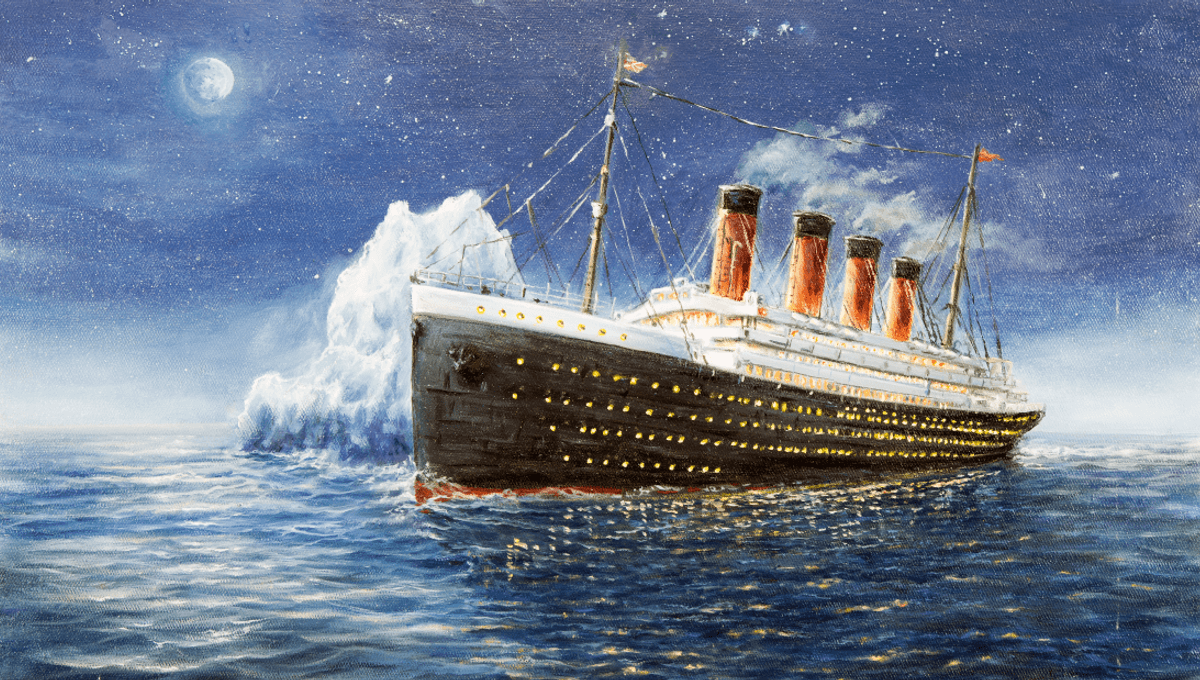
The “unsinkable ship” known as the Titanic became arguably the most infamous shipwreck in history in 1912 after it struck an iceberg. After warnings were ignored, it wasn’t until a lookout spotted the iceberg that evasive action was taken, but it was too late.
The ship’s starboard side was punctured, allowing five of 16 compartments to flood with water – one more than the ship was equipped to handle – but could things have been different if no action had been taken? Would the Titanic have sunk if it hit the iceberg head-on?
The Titanic’s Break-Up
One of the accolades that earned the Titanic its “unsinkable” status was the inclusion of 16 compartments in the hull that were believed to be watertight. Even if flooded, it was thought that the ship could remain functional if no more than four of them filled with water. Unfortunately, when the Titanic struck the iceberg, it seems water got into five of them.
This has often been quoted as the leading cause of the Titanic sinking, though a review marking the 100th Anniversary in 2012 concluded that identifying a single cause is complex. That’s because several things went wrong after the collision, like buckling of the ship’s bottom and failure of the joints due to stress.
Avoiding The Iceberg
There are several reports of other boats at sea trying to warn the Titanic of ice up ahead, but it seems that these were ignored as ice wasn’t considered a significant threat to massive ships. That meant that by the time lookout Frederick Fleet spotted the massive iceberg directly ahead, efforts to steer around it failed to avoid a collision and the starboard side was hit and the hull buckled, allowing water to rush into the compartments.
As five of the compartments were breached, the ship took on water, sinking the bow and causing the stern to rise into the air. Eventually, the ship snapped in two and the bow was fully submerged, meanwhile, air trapped in the stern saw it become vertically raised before sinking into the depths.
Hitting The Iceberg Head On
The SS Arizona was a 450-foot long ship that in 1879 hit an iceberg stem-on and sailed to tell the tale for another 50 years. Another ship, the SS Grampian, also survived a head-on collision in 1919. The two vessels by no means came out unscathed, both taking on serious damage and the SS Grampian lost two stewards, but the ships themselves didn’t sink.
So, had the Titanic taken the damage head-on rather than down its starboard side, could it too have stayed afloat? According to the YouTube channel Oceanliner Designs, the complex honeycomb structure of steel in the ship’s stern means it theoretically could’ve had enough elasticity to suffer the blow without instantly breaking apart.
The folding in that occurs when a ship hits a stationary object head-on like this is called telescoping, and in history, it’s happened to numerous ships without them sinking. Certainly, the view that Titanic could’ve stayed afloat with a head-on collision is one that was shared by Edward Wilding, deputy to Thomas Andrews in the ship’s design department.
Excerpt from the British Wreck Commissioner’s Inquiry, Day 19
The Commissioner: Do you mean to say that if this ship had driven on to the iceberg stem on she would have been saved?
Edward Wilding: I am quite sure she would, My Lord. I am afraid she would have killed every firemen down in the firemen’s quarters, but I feel sure the ship would have come in.
C: And the passengers would not have been lost?
EW: The passengers would have come in.
[…]
C: Do you think that if the helm had not been starboarded there would have been a chance of the ship being saved?
EW: I believe the ship would have been saved, and I am strengthened in that belief by the case which your Lordship will remember where one large North Atlantic steamer, some 34 years ago, did go stem on into an iceberg and did come into port, and she was going fast.
Mr. Laing: The “Arizona” – I remember it.
According to Wilding’s testimony, the Titanic would have crumpled, killing many workers in the affected part of the ship as it was crushed 24 to 30 meters (80 to 100 feet) into the bows, but she could have stayed afloat. Of course, to expect the ship’s captain to make such a call in the face of an oncoming iceberg the size of a city block wouldn’t be reasonable, but it raises interesting ideas about the design of such enormous vessels.
Furthermore, coming to an abrupt stop when ramming into the side of an enormous iceberg comes with its own fatal consequences. As the 100th-anniversary review concluded, it’s difficult to know what could have been given the complexity of the ship’s design and how the ship could have responded to such an impact, and the possible outcome of a head-on collision becomes even more murky when you take into account the fire theory.
Source Link: Would The Titanic Have Sunk If It Hit The Iceberg Head-On?